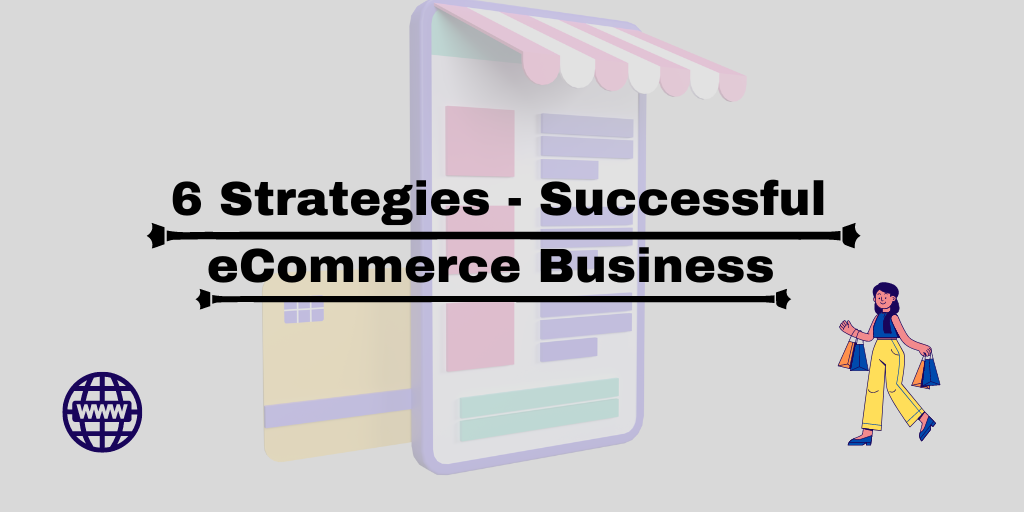6 Proven Strategies for Launching a Successful eCommerce Business in 2023

Table of Contents
Introduction
Understanding eCommerce: The Online Revolution
Strategy #1: Conduct Thorough Market Research
Strategy #2: Prioritize User Experience
Strategy #3: Optimize for Mobile
Strategy #4: Harness the Power of SEO
Strategy #5: Leverage Social Media
Strategy #6: Provide Excellent Customer Service
Conclusion
Introduction
In today's rapidly evolving digital landscape, launching an eCommerce business can be both rewarding and challenging. eCommerce offers immense potential for scalability, cost-efficiency, and accessibility, but it also demands a strategic approach to navigate the competitive online marketplace. If you're looking to dip your toes in the ocean of online commerce, this guide is just for you. Here, we will delve into seven proven strategies to launch a successful eCommerce business in 2023. Each of these tactics will provide you with actionable insights to kickstart your eCommerce journey and ensure its long-term success.
Understanding eCommerce: The Online Revolution
eCommerce, also known as online commerce, involves the exchange of goods or services through internet-based platforms. It's not just a modern convenience; it's a significant shift in how businesses operate and consumers shop. The power of eCommerce lies in its accessibility. It breaks down geographical barriers, allowing businesses to reach customers wherever they have an internet connection.
However, with the multitude of online stores vying for customers' attention, setting up a successful eCommerce business requires more than just a product or service to sell. It demands an understanding of the online marketplace, your target audience, and the strategies that can help you reach and engage with them effectively.
Now, let's delve into the strategies that can help you establish and grow your eCommerce business.
eCommerce, an abbreviation for electronic commerce, encompasses the online buying and selling of goods and services. Over the past couple of decades, eCommerce has experienced a rapid transformation, growing from a new and novel concept to a central pillar of the global economy.
This online revolution started with the advent of the internet, but it really took off with the introduction of secure payment gateways and improved internet connectivity. Nowadays, eCommerce is an integral part of our daily lives. From ordering food and clothes to booking appointments and services, the digital realm caters to virtually every consumer need.
Beyond simple convenience, eCommerce offers a democratized marketplace where businesses of all sizes can reach customers across the globe, without the need for physical storefronts or a local presence. This accessibility is a double-edged sword, however. While it presents unprecedented opportunities for businesses, it also introduces fierce competition.
In this saturated online market, it's not enough to simply have a website. Successful eCommerce involves understanding and utilizing sophisticated technologies, navigating intricate logistics, maintaining robust cybersecurity measures, and—above all—ensuring an excellent customer experience. It's about forging connections with customers, despite the absence of face-to-face interaction, and building an online brand that can attract and retain a loyal customer base.
Strategy #1: Conduct Thorough Market Research
Market research is a cornerstone of any successful business plan, and eCommerce is no exception. Understanding your market, your competitors, and your potential customers is crucial to making informed decisions about your product, pricing, and promotional strategies. Here are the essential elements to prioritize:
Target audience: Identify who your potential customers are. What are their requirements, preferences, and online habits? The more you know about your target audience, the better you can tailor your offerings and marketing efforts to meet their needs.
Competition: Who are your direct and indirect competitors? What are their strengths and weaknesses? Understanding your competition can provide insights into what works and what doesn't in your market, allowing you to differentiate your business and create a unique selling proposition.
Industry trends: Stay updated with the latest eCommerce trends. The digital world is constantly evolving, and staying ahead of these changes can give you a competitive edge. Keep an eye on technological advancements, changes in consumer behavior, and emerging eCommerce platforms.
Market research isn't a one-time task. It's an ongoing process that can help you stay aligned with your customers' needs and adapt to changes in the marketplace.
Strategy #2: Prioritize User Experience
User experience (UX) is a critical factor that can make or break your eCommerce business. A positive UX not only makes shopping on your site enjoyable but also builds trust with your customers. To enhance UX, focus on:
Website design: Your site should be visually appealing, with a clean design and easy navigation. A cluttered or confusing site can drive potential customers away.
Site speed: Slow loading times can be frustrating for shoppers and can lead to abandoned carts. Ensure that your website loads swiftly on both desktop and mobile devices.
Product descriptions and images: Provide detailed descriptions and high-quality images for your products. This can aid customers in making well-informed purchasing choices.
Easy checkout: The checkout process should be simple and secure. Offer multiple payment options and ensure that entering shipping information is straightforward.
Remember, a positive user experience can lead to higher customer satisfaction, increased loyalty, and positive word-of-mouth, all of which can boost your eCommerce success.
Strategy #3: Optimize for Mobile
With an increasing number of consumers using their smartphones for online shopping, having a mobile-friendly eCommerce site is no longer an option—it's a necessity. A site that's difficult to navigate on a mobile device can frustrate potential customers and drive them away. Here are some ways to enhance the mobile optimization of your website:
Responsive design: Ensure your website design is responsive, meaning it automatically adjusts to fit the screen size of the device it's viewed on. This provides a seamless browsing experience, whether the user is on a desktop, tablet, or smartphone.
Speed: Mobile users often have shorter attention spans, making site speed even more critical. Optimize your mobile site to load quickly to keep users engaged.
Easy checkout: The checkout process on mobile should be just as straightforward as on desktop. Consider offering digital wallets like Apple Pay or Google Pay for a faster, more convenient checkout experience.
Touch-friendly: Make sure all buttons, forms, and menus are large enough to be easily tapped on a touchscreen.
Remember, Google uses mobile-friendliness as a ranking factor, so optimizing for mobile can also boost your site's visibility in search results.
Strategy #4: Harness the Power of SEO
SEO is the process of boosting your website's visibility on search engine results pages (SERPs). Given that most online shopping journeys begin with a search engine, SEO is a critical strategy for attracting potential customers to your eCommerce site. Maximize the benefits of SEO with these strategies:
Keyword research: Identify the keywords potential customers are using to search for products like yours and incorporate them into your site content, product descriptions, and meta tags.
Site structure: An organized website facilitates smoother crawling and indexing by search engines. Implementing these strategies can enhance your visibility in search engine results pages (SERPs).
Link building: High-quality inbound links (links from other sites to yours) can boost your site's authority and improve its search rankings. Strategies for link building include guest blogging, influencer outreach, and producing shareable content.
User experience: Websites that deliver a seamless user experience are given priority by search engines. As mentioned earlier, factors like site speed, mobile-friendliness, and easy navigation can enhance user experience and, in turn, your SEO.
Remember, SEO is a long-term strategy. It takes time to see results, but the organic traffic it can bring to your site is well worth the effort.
Strategy #5: Leverage Social Media
Leverage social media platforms as potent tools to promote your eCommerce business and connect with your target audience.. They can also drive traffic to your site and boost your sales. Here's how to leverage social media for your eCommerce business:
Platform selection: Identify where your target audience spends their time online and focus your efforts on those platforms. Trying to maintain a presence on every social media site can dilute your efforts and be less effective.
Content creation: Craft compelling and shareable content that deeply connects with your audience. This could include product photos, customer testimonials, behind-the-scenes looks at your business, or helpful tips related to your products.
Engagement: Social media is a two-way street. Don't just post content—engage with your followers. Respond to comments, answer questions, and use feedback to improve your offerings.
Social commerce: Many social media platforms now allow businesses to sell products directly through their platform. This can provide a seamless shopping experience for customers and lead to increased sales.
Strategy #6: Provide Excellent Customer Service
Distinguished customer service can distinguish your eCommerce business from the competition. It can also build trust with your customers and encourage repeat business.Here are some impactful approaches to provide exceptional customer service:
Communication: Keep customers informed about their orders. Send confirmation emails, provide tracking information, and let them know if there are any delays.
Support: Offer multiple channels for customer support, such as email, phone, live chat, or even social media. Ensure that your support team is prompt and supportive in assisting customers.
Returns and refunds: Have a clear, fair policy for returns and refunds and make sure it's easy for customers to find on your site.
Feedback: Encourage regular feedback from customers and attentively listen to their suggestions and opinions. This can help you identify areas for improvement and show customers that you value their opinions.
Conclusion
Launching an eCommerce business can be a daunting venture, especially given the competitive nature of the online marketplace. However, with careful planning and strategic implementation, even the most challenging hurdles can be overcome. It's important to remember that each business is unique, and what works for one might not necessarily work for another. That's why a deep understanding of your market and your customers is pivotal.
Moreover, the world of eCommerce is not a static one. As technological innovations continue to emerge and consumer behavior evolves, it's crucial for businesses to stay agile and adaptable. Being open to change and willing to take calculated risks are key to maintaining a competitive edge.
Each of the strategies discussed in this article offers a piece of the eCommerce success puzzle. Market research enables you to understand your audience and carve out a unique space in the market. Choosing the right eCommerce platform lays the foundation for your online operations. Prioritizing user experience helps foster customer satisfaction and loyalty. Optimizing for mobile ensures accessibility for an increasingly mobile audience. Harnessing the power of SEO helps attract organic traffic. Leveraging social media allows you to reach and engage with your audience on platforms they frequent. Providing excellent customer service builds trust and encourages repeat business.
In essence, launching a successful eCommerce business is about more than selling products or services online—it's about creating an engaging, reliable, and enjoyable shopping experience that resonates with your customers. It's a journey that requires consistent effort, continuous learning, and a healthy dose of perseverance. But with the right strategies in your arsenal, you'll be well-equipped to navigate this journey and make your mark in the exciting world of eCommerce.
In the dynamic world of eCommerce, there's always something new to learn, a trend to follow, or a technology to adopt. Staying adaptable and receptive to change is the key to long-term success. Start with these seven proven strategies, and you'll be well on your way to launching a successful eCommerce business in 2023. Good luck!


